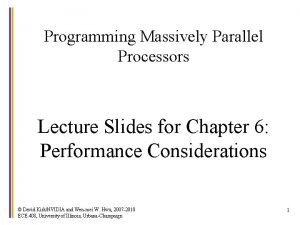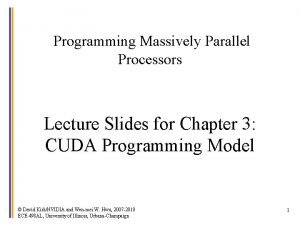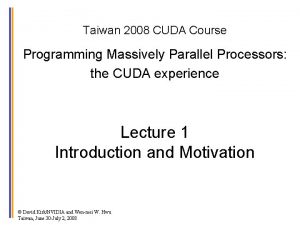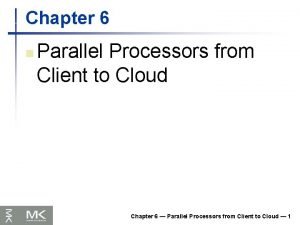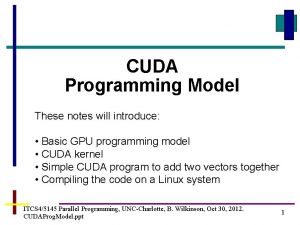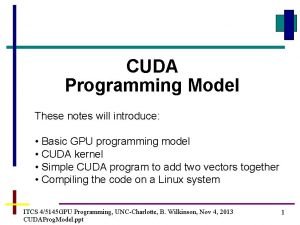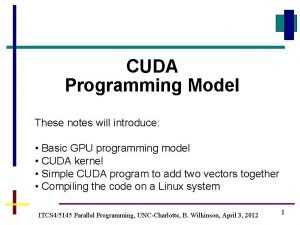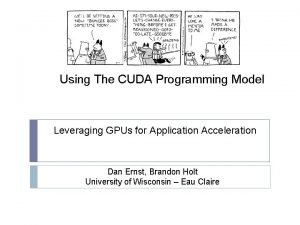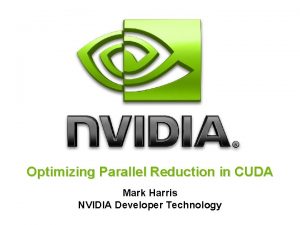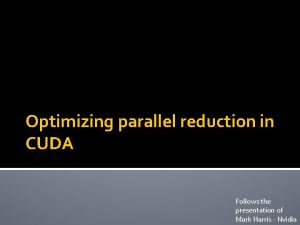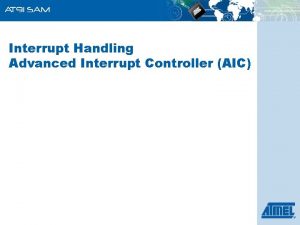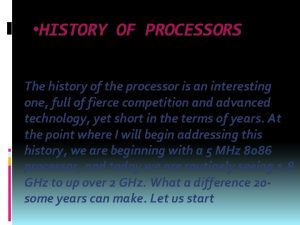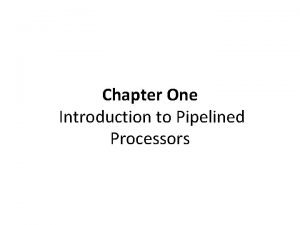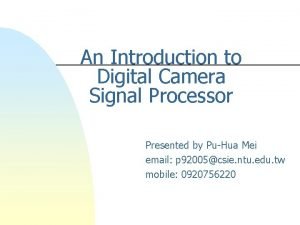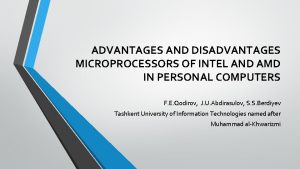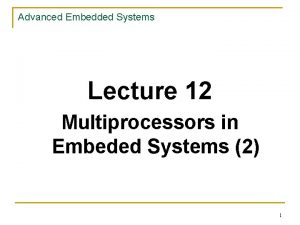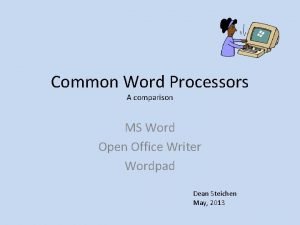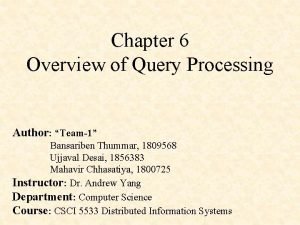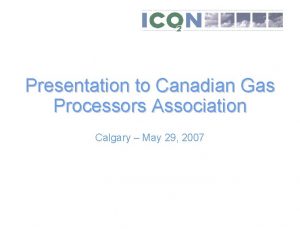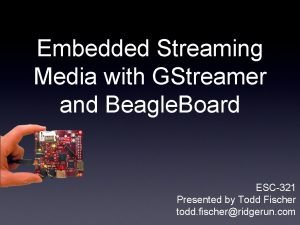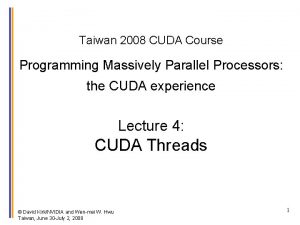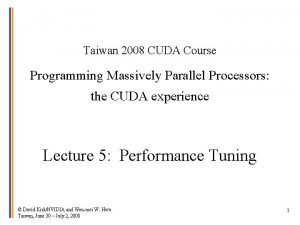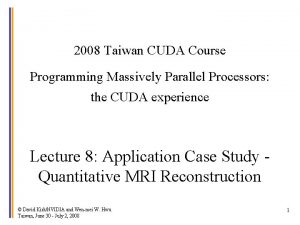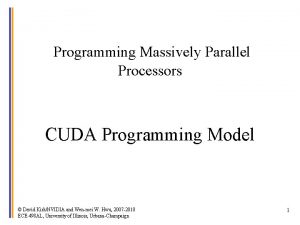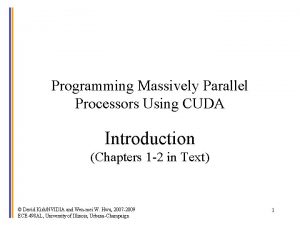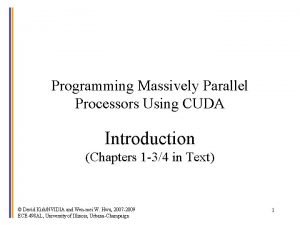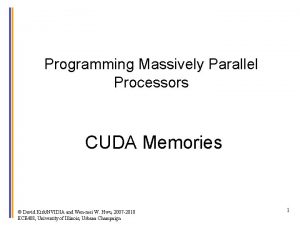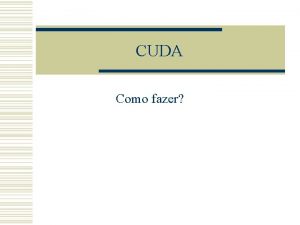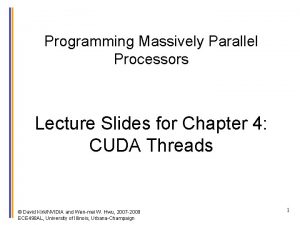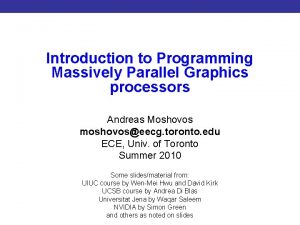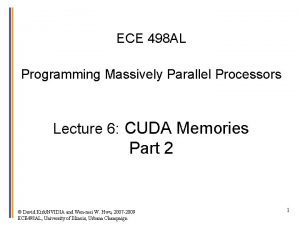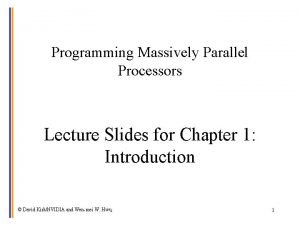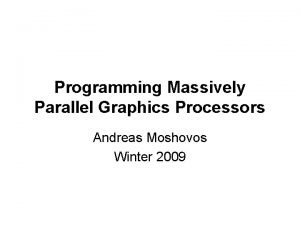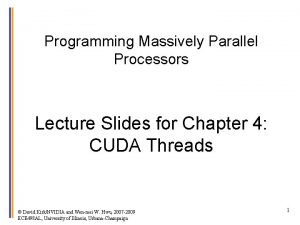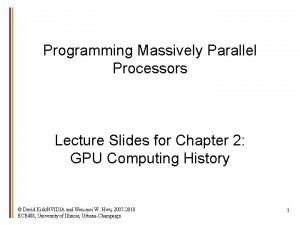Taiwan 2008 CUDA Course Programming Massively Parallel Processors




















![Key Issue: Synchronization Matrixmul(A[ ], B[ ], C[ ]) { __shared__ Asub[ ][ ], Key Issue: Synchronization Matrixmul(A[ ], B[ ], C[ ]) { __shared__ Asub[ ][ ],](https://slidetodoc.com/presentation_image_h/2ef1f1079b40b59dd5e93c95d6330f67/image-21.jpg)
![Synchronization solution Matrixmul(A[ ], B[ ], C[ ]) { __shared__ Asub[ ][ ], Bsub[ Synchronization solution Matrixmul(A[ ], B[ ], C[ ]) { __shared__ Asub[ ][ ], Bsub[](https://slidetodoc.com/presentation_image_h/2ef1f1079b40b59dd5e93c95d6330f67/image-22.jpg)

- Slides: 23

Taiwan 2008 CUDA Course Programming Massively Parallel Processors: the CUDA experience Lecture 6 Floating-Point Considerations and CUDA for Multi. Core CPU © David Kirk/NVIDIA and Wen-mei W. Hwu Taiwan, June 30 – July 2, 2008 1

Objective • To understand the fundamentals of floating-point representation • To know the IEEE-754 Floating Point Standard • Ge. Force 8800 CUDA Floating-point speed, accuracy and precision – – Deviations from IEEE-754 Accuracy of device runtime functions fastmath compiler option Future performance considerations © David Kirk/NVIDIA and Wen-mei W. Hwu Taiwan, June 30 – July 2, 2008 2

GPU Floating Point Features G 80 SSE IBM Altivec Cell SPE Precision IEEE 754 Rounding modes for FADD and FMUL Round to nearest and round to zero All 4 IEEE, round to nearest, zero, inf, -inf Round to nearest only Round to zero/truncate only Denormal handling Flush to zero Supported, 1000’s of cycles Flush to zero Na. N support Yes Yes No Overflow and Infinity Yes, only clamps to support max norm Yes No, infinity Flags No Yes Some Square root Software only Hardware Software only Division Software only Hardware Software only Reciprocal estimate accuracy 24 bit 12 bit Reciprocal sqrt estimate accuracy 23 bit 12 bit log 2(x) and 2^x estimates accuracy 23 bit No 12 bit No © David Kirk/NVIDIA and Wen-mei W. Hwu Taiwan, June 30 – July 2, 2008 3

What is IEEE floating-point format? • A floating point binary number consists of three parts: – sign (S), exponent (E), and mantissa (M). – Each (S, E, M) pattern uniquely identifies a floating point number. • For each bit pattern, its IEEE floating-point value is derived as: – value = (-1)S * M * {2 E}, where 1. 0 ≤ M < 10. 0 B • The interpretation of S is simple: S=0 results in a positive number and S=1 a negative number. © David Kirk/NVIDIA and Wen-mei W. Hwu Taiwan, June 30 – July 2, 2008 4

Normalized Representation • Specifying that 1. 0 B ≤ M < 10. 0 B makes the mantissa value for each floating point number unique. – For example, the only one mantissa value allowed for 0. 5 D is M =1. 0 • 0. 5 D = 1. 0 B * 2 -1 – Neither 10. 0 B * 2 -2 nor 0. 1 B * 2 0 qualifies • Because all mantissa values are of the form 1. XX…, one can omit the “ 1. ” part in the representation. – The mantissa value of 0. 5 D in a 2 -bit mantissa is 00, which is derived by omitting “ 1. ” from 1. 00. © David Kirk/NVIDIA and Wen-mei W. Hwu Taiwan, June 30 – July 2, 2008 5

Exponent Representation • In an n-bits exponent representation, 2 n-1 -1 is added to its 2's complement representation to form its excess representation. – See Table for a 3 -bit exponent representation • A simple unsigned integer comparator can be used to compare the magnitude of two FP numbers • Symmetric range for +/- exponents (111 reserved) © David Kirk/NVIDIA and Wen-mei W. Hwu Taiwan, June 30 – July 2, 2008 2’s complement Actual decimal Excess-3 000 0 011 001 1 100 010 2 101 011 3 110 100 (reserved pattern) 111 101 -3 000 110 -2 001 111 -1 010 6

A simple, hypothetical 5 -bit FP format • Assume 1 -bit S, 2 -bit E, and 2 -bit M – 0. 5 D = 1. 00 B * 2 -1 – 0. 5 D = 0 00 00, where S = 0, E = 00, and M = (1. )00 © David Kirk/NVIDIA and Wen-mei W. Hwu Taiwan, June 30 – July 2, 2008 2’s complement Actual decimal Excess-1 00 0 01 01 1 10 10 (reserved pattern) 11 11 -1 00 7

Representable Numbers • The representable numbers of a given format is the set of all numbers that can be exactly represented in the format. • See Table for representable numbers of an unsigned 3 -bit integer format -1 0 1 000 0 001 1 010 2 011 3 100 4 101 5 110 6 111 7 2 3 4 5 6 7 8 9 © David Kirk/NVIDIA and Wen-mei W. Hwu Taiwan, June 30 – July 2, 2008 8

Representable Numbers of a 5 -bit Cannot represent Zero! Hypothetical IEEE Format Abrupt underflow No-zero 0 E M 00 00 2 -1 -(2 -1) 0 0 01 2 -1+1*2 -3 -(2 -1+1*2 -3) 0 0 1*2 -2 -1*2 -2 10 2 -1+2*2 -3 -(2 -1+2*2 -3) 0 0 2*2 -2 -2*2 -2 11 2 -1+3*2 -3 -(2 -1+3*2 -3) 0 0 3*2 -2 -3*2 -2 00 20 -(20) 01 20+1*2 -2 -(20+1*2 -2) 10 20+2*2 -2 -(20+2*2 -2) 11 20+3*2 -2 -(20+3*2 -2) 00 21 -(21) 01 21+1*2 -1 -(21+1*2 -1) 10 21+2*2 -1 -(21+2*2 -1) 11 21+3*2 -1 -(21+3*2 -1) 01 10 S=0 Gradual underflow S=1 11 © David Kirk/NVIDIA and Wen-mei W. Hwu Taiwan, June 30 – July 2, 2008 S=1 Reserved pattern S=0 S=1 9

Flush to Zero • Treat all bit patterns with E=0 as 0. 0 – This takes away several representable numbers near zero and lump them all into 0. 0 – For a representation with large M, a large number of representable numbers will be removed. 0 0 1 © David Kirk/NVIDIA and Wen-mei W. Hwu Taiwan, June 30 – July 2, 2008 2 3 4 10

Flush to Zero No-zero 0 E M 00 00 2 -1 -(2 -1) 0 0 01 2 -1+1*2 -3 -(2 -1+1*2 -3) 0 0 1*2 -2 -1*2 -2 10 2 -1+2*2 -3 -(2 -1+2*2 -3) 0 0 2*2 -2 -2*2 -2 11 2 -1+3*2 -3 -(2 -1+3*2 -3) 0 0 3*2 -2 -3*2 -2 00 20 -(20) 01 20+1*2 -2 -(20+1*2 -2) 10 20+2*2 -2 -(20+2*2 -2) 11 20+3*2 -2 -(20+3*2 -2) 00 21 -(21) 01 21+1*2 -1 -(21+1*2 -1) 10 21+2*2 -1 -(21+2*2 -1) 11 21+3*2 -1 -(21+3*2 -1) 01 10 S=0 Denormalized Flush to Zero S=1 © David Kirk/NVIDIA and Wen-mei W. Hwu 11 Taiwan, June 30 – July 2, 2008 S=0 S=1 Reserved pattern S=1 11

Denormalized Numbers • The actual method adopted by the IEEE standard is called denromalized numbers or gradual underflow. – The method relaxes the normalization requirement for numbers very close to 0. – whenever E=0, the mantissa is no longer assumed to be of the form 1. XX. Rather, it is assumed to be 0. XX. In general, if the n-bit exponent is 0, the value is • 0. M * 2 - 2 ^(n-1) + 2 0 1 © David Kirk/NVIDIA and Wen-mei W. Hwu Taiwan, June 30 – July 2, 2008 2 3 12

Denormalized Numbers No-zero 0 M 00 00 2 -1 -(2 -1) 0 0 01 2 -1+1*2 -3 -(2 -1+1*2 -3) 0 0 1*2 -2 -1*2 -2 10 2 -1+2*2 -3 -(2 -1+2*2 -3) 0 0 2*2 -2 -2*2 -2 11 2 -1+3*2 -3 -(2 -1+3*2 -3) 0 0 3*2 -2 -3*2 -2 00 20 -(20) 01 20+1*2 -2 -(20+1*2 -2) 10 20+2*2 -2 -(20+2*2 -2) 11 20+3*2 -2 -(20+3*2 -2) 00 21 -(21) 01 21+1*2 -1 -(21+1*2 -1) 10 21+2*2 -1 -(21+2*2 -1) 11 21+3*2 -1 -(21+3*2 -1) 10 S=1 © David Kirk/NVIDIA and Wen-mei W. Hwu 11 Taiwan, June 30 – July 2, 2008 S=0 Denormalized E 01 S=0 Flush to Zero S=1 Reserved pattern S=0 S=1 13

Arithmetic Instruction Throughput • int and float add, shift, min, max and float mul, mad: 4 cycles per warp – int multiply (*) is by default 32 -bit • – • requires multiple cycles / warp Use __mul 24() / __umul 24() intrinsics for 4 -cycle 24 -bit int multiply Integer divide and modulo are expensive – – – Compiler will convert literal power-of-2 divides to shifts Be explicit in cases where compiler can’t tell that divisor is a power of 2! Useful trick: foo % n == foo & (n-1) if n is a power of 2 © David Kirk/NVIDIA and Wen-mei W. Hwu Taiwan, June 30 – July 2, 2008 14

Arithmetic Instruction Throughput • Reciprocal, reciprocal square root, sin/cos, log, exp: 16 cycles per warp – These are the versions prefixed with “__” – Examples: __rcp(), __sin(), __exp() • Other functions are combinations of the above – y / x == rcp(x) * y == 20 cycles per warp – sqrt(x) == rcp(rsqrt(x)) == 32 cycles per warp © David Kirk/NVIDIA and Wen-mei W. Hwu Taiwan, June 30 – July 2, 2008 15

Runtime Math Library • There are two types of runtime math operations – __func(): direct mapping to hardware ISA • Fast but low accuracy (see prog. guide for details) • Examples: __sin(x), __exp(x), __pow(x, y) – func() : compile to multiple instructions • Slower but higher accuracy (5 ulp, units in the least place, or less) • Examples: sin(x), exp(x), pow(x, y) • The -use_fast_math compiler option forces every func() to compile to __func() © David Kirk/NVIDIA and Wen-mei W. Hwu Taiwan, June 30 – July 2, 2008 16

Make your program float-safe! • Future hardware will have double precision support – – – • G 80 is single-precision only Double precision will have additional performance cost Careless use of double or undeclared types may run more slowly on G 80+ Important to be float-safe (be explicit whenever you want single precision) to avoid using double precision where it is not needed – Add ‘f’ specifier on float literals: • foo = bar * 0. 123; • foo = bar * 0. 123 f; – // double assumed // float explicit Use float version of standard library functions • foo = sin(bar); • foo = sinf(bar); © David Kirk/NVIDIA and Wen-mei W. Hwu Taiwan, June 30 – July 2, 2008 // double assumed // single precision explicit 17

Deviations from IEEE-754 • Addition and Multiplication are IEEE 754 compliant – Maximum 0. 5 ulp (units in the least place) error • However, often combined into multiply-add (FMAD) – Intermediate result is truncated • • Division is non-compliant (2 ulp) Not all rounding modes are supported Denormalized numbers are not supported No mechanism to detect floating-point exceptions © David Kirk/NVIDIA and Wen-mei W. Hwu Taiwan, June 30 – July 2, 2008 18

GPU Floating Point Features G 80 SSE IBM Altivec Cell SPE Precision IEEE 754 Rounding modes for FADD and FMUL Round to nearest and round to zero All 4 IEEE, round to nearest, zero, inf, -inf Round to nearest only Round to zero/truncate only Denormal handling Flush to zero Supported, 1000’s of cycles Flush to zero Na. N support Yes Yes No Overflow and Infinity Yes, only clamps to support max norm Yes No, infinity Flags No Yes Some Square root Software only Hardware Software only Division Software only Hardware Software only Reciprocal estimate accuracy 24 bit 12 bit Reciprocal sqrt estimate accuracy 23 bit 12 bit log 2(x) and 2^x estimates accuracy 23 bit No 12 bit No © David Kirk/NVIDIA and Wen-mei W. Hwu Taiwan, June 30 – July 2, 2008 19

Coming Soon – CUDA Kernels on Multi-core CPU • Most application developers do not want to write special code for each architecture – CUDA kernels are currently special code for GPUs – MCUDA allows efficient execution of CUDA kernels on multi-core CPUs • • • A single GPU thread is too small for a CPU Thread – CUDA emulation does this and performs poorly CPU cores designed for ILP, SIMD – Optimizing compilers work well with iterative loops Turn GPU thread blocks from CUDA into iterative CPU loops © David Kirk/NVIDIA and Wen-mei W. Hwu Taiwan, June 30 – July 2, 2008 20
![Key Issue Synchronization MatrixmulA B C shared Asub Key Issue: Synchronization Matrixmul(A[ ], B[ ], C[ ]) { __shared__ Asub[ ][ ],](https://slidetodoc.com/presentation_image_h/2ef1f1079b40b59dd5e93c95d6330f67/image-21.jpg)
Key Issue: Synchronization Matrixmul(A[ ], B[ ], C[ ]) { __shared__ Asub[ ][ ], Bsub[ ][ ]; int a, b, c; float Csub; int k; … for(…) • Suspend and Wakeup – Move on to other threads – Begin again after all hit barrier { Asub[tx][ty] = A[a]; Bsub[tx][ty] = B[b]; __syncthreads(); for( k = 0; k < block. Dim. x; k++ ) Csub += Asub[ty][k] + Bsub[k][tx]; __syncthreads(); © David Kirk/NVIDIA and Wen-mei W. Hwu Taiwan, June 30 – July 2, 2008 } … } 21
![Synchronization solution MatrixmulA B C shared Asub Bsub Synchronization solution Matrixmul(A[ ], B[ ], C[ ]) { __shared__ Asub[ ][ ], Bsub[](https://slidetodoc.com/presentation_image_h/2ef1f1079b40b59dd5e93c95d6330f67/image-22.jpg)
Synchronization solution Matrixmul(A[ ], B[ ], C[ ]) { __shared__ Asub[ ][ ], Bsub[ ][ ]; int a, b, c; float Csub; int k; … for(…) • Loop fission { for(ty=0; ty < block. Dim. y; ty++) for(tx=0; tx < block. Dim. x; tx++) { Asub[tx][ty] = A[a]; Bsub[tx][ty] = B[b]; } – Break the loop into multiple smaller loops according to for(ty=0; ty < block. Dim. y; ty++) for(tx=0; tx < block. Dim. x; tx++) syncthreads() { – Not always possible with for( k = 0; k < block. Dim. x; k++ ) Csub += Asub[ty][k] + Bsub[k][tx]; synchthreads() in control } flow } © David Kirk/NVIDIA and Wen-mei W. Hwu Taiwan, June 30 – July 2, 2008 … } 22

Bigger Picture Performance Results • Consistent speed-up over hand-tuned single-thread code • Best optimizations for GPU and CPU not always the same Application CPU Time MRI-FHD ~1000 s 230 s ~4 x 8. 5 s 180 s 45 s 4 x 8. 5 s SAD 42. 5 ms 25. 6 ms 1. 66 x 4. 75 ms MM (4 Kx 4 K) 7. 84 s** 15. 5 s 3. 69 x 1. 12 s CP CUDA on CPU Time Speedup* CUDA on G 80 Time *Over hand-optimized CPU **Intel MKL, multi-core execution © David Kirk/NVIDIA and Wen-mei W. Hwu Taiwan, June 30 – July 2, 2008 23
 Programming massively parallel processors
Programming massively parallel processors Programming massively parallel processors
Programming massively parallel processors Massively parallel processing ppt
Massively parallel processing ppt Programming massively parallel processors, kirk et al.
Programming massively parallel processors, kirk et al. Parallel processors from client to cloud
Parallel processors from client to cloud 2008 2008
2008 2008 Cuda programming model
Cuda programming model Cuda programming model
Cuda programming model Cuda programming model
Cuda programming model Cuda programming model
Cuda programming model Parallel reduction cuda
Parallel reduction cuda Optimizing parallel reduction in cuda
Optimizing parallel reduction in cuda Pipeline is a linear
Pipeline is a linear Interrupt handling in arm processors
Interrupt handling in arm processors The history of cpu
The history of cpu Handler's classification
Handler's classification Digital camera processors
Digital camera processors Advantages of intel processor
Advantages of intel processor Embeded processors
Embeded processors Microcontrollers and embedded processors
Microcontrollers and embedded processors Comparison of word processors
Comparison of word processors Characteristics of query processor
Characteristics of query processor Gas processors association
Gas processors association Beagleboard embedded processors
Beagleboard embedded processors

